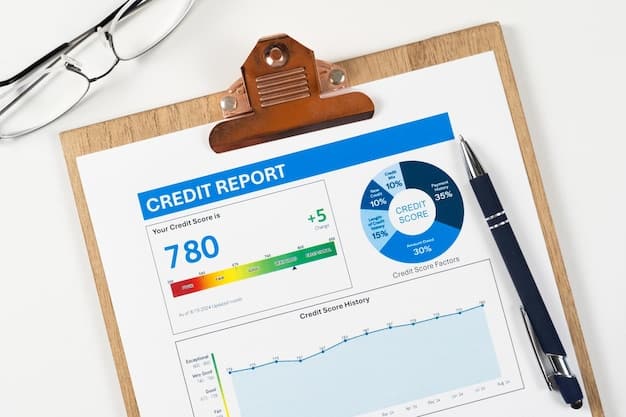Negotiate Lower Credit Card Rates in 2025: The Ultimate Guide

The Ultimate Guide to Negotiating Lower Interest Rates on Your Credit Cards in 2025 provides actionable strategies and insights to help you reduce your credit card APR, save money on interest charges, and improve your financial health by leveraging negotiation tactics and understanding market trends.
Are you aiming to reduce your credit card expenses? The Ultimate Guide to Negotiating Lower Interest Rates on Your Credit Cards in 2025 will equip you with effective methods to lower your APR, save money on interest, and enhance your financial well-being.
Understanding the Importance of a Lower APR
A lower Annual Percentage Rate (APR) on your credit cards can significantly impact your financial health. Understanding why it’s important is the first step in taking control of your credit card debt.
The APR determines how much interest you pay on your outstanding balance. The higher the APR, the more money you’ll spend on interest charges over time. By negotiating a lower rate, you can save a substantial amount, allowing you to pay off your debt faster and free up funds for other financial goals.
The Impact on Your Monthly Payments
A lower APR directly reduces the amount of interest accruing on your balance each month. This means more of your payment goes towards the principal, allowing you to pay down your debt more quickly.
Long-Term Savings Potential
Over time, the savings from a lower APR can be substantial. Even a small decrease in your interest rate can lead to hundreds or even thousands of dollars saved over the life of your debt. This saved money can be reinvested or used for other important life expenses.
- Reduces overall interest paid: Lower APRs mean less money spent on interest charges.
- Accelerates debt repayment: More of your payment goes towards the principal balance.
- Improves cash flow: Frees up funds for other financial needs and goals.
Understanding the importance of a lower APR is the foundation for effective negotiation and financial planning. It sets the stage for employing various strategies to achieve a better rate.
Assessing Your Creditworthiness
Before you start negotiating, understanding your creditworthiness is crucial. Credit card companies assess your risk based on several factors, and knowing where you stand can significantly improve your negotiation position.
Your credit score is a primary indicator. A good to excellent credit score demonstrates responsible credit management. Additionally, your payment history, credit utilization ratio, and any existing debt also play roles in determining your creditworthiness.

Checking Your Credit Score
Obtain your credit report from major credit bureaus like Experian, Equifax, and TransUnion. Review it for accuracy and identify any areas that may need improvement. Correcting errors can boost your credit score.
Improving Your Credit Profile
If your credit score isn’t ideal, take steps to improve it before negotiating. This includes paying bills on time, reducing your credit utilization ratio, and avoiding new credit applications.
Understanding Your Credit Utilization Ratio
Credit utilization is the amount of credit you’re using compared to your total available credit. Aim to keep this below 30% to demonstrate responsible credit management. Lower utilization can have a positive impact on your credit score and negotiation power.
- Obtain your credit report: Review your credit history for accuracy.
- Address any errors: Correct inaccuracies to improve your credit score.
- Reduce credit utilization: Keep balances low relative to credit limits.
Assessing your creditworthiness empowers you with valuable information. It enables you to present yourself as a low-risk borrower, making credit card companies more inclined to offer a lower APR.
Preparing for the Negotiation
Effective negotiation requires preparation. Gathering relevant information and formulating a clear negotiation strategy can significantly increase your chances of success.
Research current interest rates, understand your card’s terms and conditions, and document your positive payment history. Having this information readily available will strengthen your arguments during the negotiation process.
Researching Current Interest Rates
Stay informed about the prevailing interest rates for credit cards. Websites like Bankrate and Credit Karma provide data on average APRs, helping you determine a reasonable rate to aim for.
Knowing Your Card’s Terms and Conditions
Review your credit card agreement thoroughly. Understanding the terms and conditions provides insights into your current APR, any applicable fees, and the card’s specific policies.
Documenting Your Payment History
Compile records of your consistent on-time payments. A strong payment history demonstrates your reliability as a borrower and can be a compelling argument for a lower APR.
Preparing for negotiation involves gathering market data, understanding your card’s specifics, and highlighting your responsible payment behavior. Informed preparation increases your confidence and strengthens your negotiation stance.
Strategies for Negotiating a Lower APR
Negotiating a lower APR involves employing effective communication tactics and leveraging your strengths as a customer. Approach the conversation with confidence, politeness, and a clear understanding of your goals.
Start by contacting your credit card company’s customer service department. Explain your reasons for requesting a lower APR, emphasizing your long-term relationship and positive payment history. Be prepared to provide supporting documentation and articulate the value you bring as a customer.
Contacting Customer Service
Initiate the negotiation by contacting the customer service department. Be polite and professional, clearly stating your intention to negotiate a lower APR.
Highlighting Your Customer Loyalty
Emphasize your long-term relationship with the credit card company. Highlight your consistent on-time payments and overall loyalty as a customer.

Mentioning Competitor Offers
Inform the representative that you are aware of lower APR offers from competitors. This can create a sense of urgency and incentivize the company to retain your business by matching or beating those offers.
- Be polite and professional: Approach the conversation with a respectful attitude.
- State your reasons clearly: Explain why you are requesting a lower APR.
- Leverage competitor offers: Use available market data to your advantage.
Successful negotiation involves clear communication, highlighting your value as a customer, and leveraging competitive offers. This strategic approach can lead to a favorable outcome and a lower APR on your credit card.
When to Negotiate: Timing is Key
The timing of your negotiation can influence its success. Certain times of the year or specific circumstances may be more conducive to securing a lower APR.
Consider negotiating when you have a strong credit profile, during promotional periods, or in response to a significant life event. Timing your negotiation strategically can increase your chances of achieving a favorable outcome.
Negotiating After a Credit Score Increase
If you’ve recently improved your credit score, it’s an opportune time to negotiate. Provide updated credit reports to showcase your improved creditworthiness.
Negotiating During Promotional Periods
Credit card companies often offer promotional rates to attract new customers. Leverage these promotions by requesting a similar rate, emphasizing your loyalty as an existing customer.
Negotiating After a Significant Life Event
Significant life events, such as a job promotion or debt consolidation, can improve your financial standing. Use these events as leverage to demonstrate your reduced risk.
Timing your negotiation strategically involves leveraging periods of improved creditworthiness, promotions, or significant life events. This tactical approach can enhance your negotiation power and increase the likelihood of securing a lower APR.
Alternative Strategies if Negotiation Fails
If direct negotiation proves unsuccessful, alternative strategies can still help you lower your credit card interest rates. Explore options such as balance transfers, debt consolidation, and credit counseling.
Balance transfers involve moving your existing credit card debt to a new card with a lower APR. Debt consolidation combines multiple debts into a single loan with more favorable terms. Credit counseling provides personalized guidance and support to manage your debt effectively.
Balance Transfers
Consider transferring your balance to a credit card with a lower introductory APR. This can provide temporary relief from high interest charges, allowing you to pay down your debt faster.
Debt Consolidation
Explore debt consolidation loans, which combine multiple debts into a single loan with a fixed interest rate. This can simplify your payments and reduce your overall interest costs.
Credit Counseling
Seek assistance from a reputable credit counseling agency. Counselors can provide personalized debt management strategies and negotiate with creditors on your behalf.
- Balance Transfers: Move debt to a lower APR card.
- Debt Consolidation: Combine multiple debts into a single loan.
- Credit Counseling: Get professional guidance and support.
In cases where direct negotiation fails, alternative strategies such as balance transfers, debt consolidation, and credit counseling offer viable pathways to reduce your credit card interest rates and manage your debt effectively.
| Key Point | Brief Description |
|---|---|
| 💡 Understand APR | APR determines your interest costs. Lower is better! |
| 📈 Check Credit | A good credit score is key to negotiating lower rates. |
| 📞 Negotiate | Call your card issuer and politely request a lower APR. |
| 🔄 Balance Transfer | Move your balance to a card with a lower introductory rate. |
Frequently Asked Questions (FAQs)
▼
APR (Annual Percentage Rate) is the yearly interest rate you’re charged on outstanding credit card balances. A lower APR means you’ll pay less in interest, saving you money and helping you pay off debt faster.
▼
You can negotiate your APR as often as you like, but it’s generally recommended to wait at least six months between requests. Significant improvements in your credit profile may warrant more frequent attempts.
▼
If negotiation fails, explore alternatives like balance transfers or debt consolidation. You can also seek credit counseling for personalized guidance on managing your debt.
▼
Simply asking for a lower APR does not directly hurt your credit score. However, if the credit card company checks your credit report during the negotiation, it could result in a small, temporary dip.
▼
Have your credit report, records of on-time payments, and information on competitor offers readily available. Being prepared strengthens your negotiation position and demonstrates your seriousness.
Conclusion
Negotiating lower interest rates on your credit cards in 2025 requires a combination of understanding, preparation, and effective communication. By assessing your creditworthiness, researching market rates, and employing strategic negotiation tactics, you can significantly reduce your APR and improve your financial well-being.





